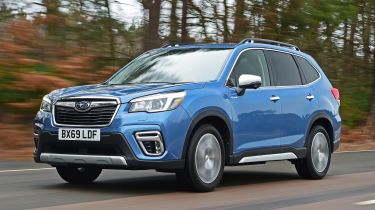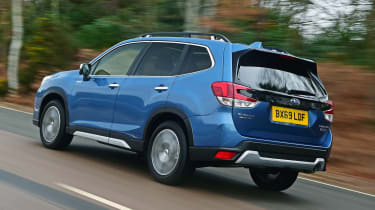New Subaru Forester e-Boxer 2020 review
The new Subaru Forester e-Boxer boasts mild-hybrid tech, but has it boosted the SUV’s appeal?

The Subaru Forester isn’t a car that you buy with your head, because there are plenty of rivals which offer a broader range of ability and – more importantly – better fuel economy. However, if you’re after a practical, no-nonsense SUV that isn’t fazed by rough terrain, the Forester e-Boxer makes a convincing choice. Just be prepared to pay for it.
The new mild-hybrid Subaru Forester has been tasked with combating the SUV’s reputation for poor fuel economy. It joins a heavily populated marketplace of mid-sized off-roaders, rivalling the Toyota RAV4, Mazda CX-5 and Volkswagen Tiguan, and this is our first chance to test it in the UK.
Unlike Foresters of old, this new model has ditched turbocharging for mild-hybrid drive in a bid to improve economy and emissions. The Forester is now only available with Subaru’s e-Boxer powertrain, which comprises a naturally aspirated 2.0-litre flat-four petrol engine, a compact lithium-ion battery pack and a gearbox-mounted electric motor for a combined output of 148bhp and 196Nm of torque.
The shift to hybrid drive has produced mixed results. While a claimed emissions figure of 154g/km is reasonable for an SUV of this size, the Forester’s fuel economy falls short; don’t expect to see more than 35mpg in the real world. Although Subaru says the Forester can operate in pure EV-mode at up to 25mph, we rarely got near that speed before the engine kicked in.
The petrol engine and electric motor work best as a team, with the motor filling in the gaps in the combustion engine’s power band – but the e-Boxer system still feels a little sluggish. Due to the engine’s lack of a turbocharger, you have to work the powertrain quite hard when merging onto the motorway or overtaking. There’s also a considerable amount of road noise at speed and the petrol engine is jerky to re-engage after running in electric mode.
Used - available now

2020 Subaru
Forester
26,847 milesAutomaticPetrol2.0L
Cash £21,499
2020 Subaru
Forester
36,496 milesAutomaticPetrol2.0L
Cash £21,000
2020 Subaru
Forester
21,801 milesAutomaticPetrol2.0L
Cash £24,950
2020 Subaru
Forester
21,081 milesAutomaticPetrol2.0L
Cash £21,500Refinement issues aside, though, the Forester e-Boxer is a comfortable place to be. Its chassis is well damped and composed, soaking up all but the harshest of road imperfections, while Subaru’s CVT gearbox manages the combustion engine well, preventing the revs from soaring under hard acceleration.
The Forester is far better suited to off-road driving. Thanks to its high ground-clearance, permanent all-wheel-drive system and selectable terrain settings, it can tackle ground that would stump more style-focused competitors such as the SEAT Ateca or Peugeot 3008.
It’s practical, too; there’s plenty of space in the cabin, with ample leg and headroom for all passengers and enough space in the back for three adults. The boot’s a decent size, as well, boasting a 520-litre capacity with the rear bench in place and 1,779 litres of space with the seats stowed, which is better than both the CX-5 and Tiguan.
In traditional Subaru fashion, the Forester’s interior is tech-laden and quirky, with a cluttered dashboard, a busy multifunction steering wheel, digital instruments and an eight-inch infotainment system.
There’s a long list of safety technology, too, with Subaru’s EyeSight driver-monitoring system a standout feature. It keeps tabs on the driver’s actions, to ensure they’re regularly checking their mirrors, and lane discipline. It’s a clever system, but slightly irritating, because it sometimes fail to recognise a brief glimpse in the mirror, issuing the driver with an annoying audible warning.










